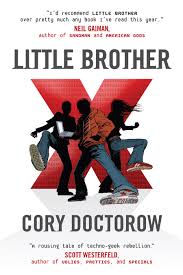
Little Brother by Cory Doctorow
ISBN: 978-0-7653-1985-2
Doctorow, C. (2008). Little brother. New York: Tor Teen.
Plot Summary
Marcus Yallow aka W1n5t0n aka M1k3y is a seventeen-year-old high school student with an obsession for privacy, security, and computers. He and his friends Van, Jolu, and Darryl play an alternate reality game (ARG) called Harajuku Fun Madness. The four skip out of school early, but in the middle of their game there seems to be an attack. They race to a safe area, but witness people trampled to their death and decide to leave. Darryl has been stabbed so Marcus runs into the street when a government car drives by. Instead of helping, people jump out of the car, attack them, blindfold them, and take them to some ship or island. They are all separated and questioned about where they where when the terrorists attacked, and if they were involved in any way. After a week Van, Jolu, and Marcus are released, and Marcus vows to get back at the government. With Jolu’s help and his new girlfriend Ange, Marcus uses the Xnet, an untraceable online server, and begins to wreak havoc on local authorities. Marcus is afraid the government will be able to track him eventually, but he has to do something to save Darryl and let the country know what happened to him.
Critical Evaluation
An excellently written story, Little Brother is a kind of updated 1984. Marcus and his friends are all incredibly gifted computer programmers and players. They go beyond the gamer to those who create the game, and try their hand at hacking. Although surveillance software has permeated their world, Marcus and his friends seem to have an above-average awareness and knowledge for high school students. It seems a bit unrealistic that teens would be so concerned with who is watching them. Sophisticated explanations of high-tech gadgets may bore some readers, but glossing over these accounts will not lose any of the plot. Doctorow attempts to simplify the technology, but for those unfamiliar with surveillance software and Internet tracers, these explanations will still go over heads. Also, for an event that caused so much chaos, the details of the terrorist attack are never explained, or even really mentioned. Doctorow is likely trying to make the point that the Why or Who is not the important part, but the What. Despite these potential issues, Doctorow has created a first-rate story of political intrigue and the little guy going up against the big government. Marcus is acting as an anarchist, but his actions are always conveyed as justifiable. He is an unexpected hero who is willing to take on any adversary to help a friend, and make the country see what is really going on.
Reader’s Annotation
After a terrorist attack in San Francisco, the United States government detains Marcus and his computer savvy friends. After their release, they turn to the Internet to find a way to help their still missing friend.
About the Author
Cory Doctorow sold his first writings at 17 and has continued to write. His first novel was released in 2003. Since then Doctorow has written a book of short stories, more adult science fiction novels, and nonfiction. Little Brother is his first novel for young adults, and he has since written two more. Doctorow won four awards for Little Brother and an additional four for his other works. He writes fiction books and nonfiction about copyright and technology.
Cory Doctorow was born in 1971 to teachers. Doctorow writes science fiction novels, blogs, and is an activist for technology. He simultaneously publishes his novels with Tor and releases them as free e-books under Creative Commons licenses. This ultimately increases sales as readers share his books with friends who go out and share some more. Doctorow appreciates that copyright laws prohibit others from profiting from his work, but believes sharing freely should be allowed and encouraged. He was a former director of a non-profit organization that defended freedom in technology law, policy, standards, and treaties. He lives with his wife and young daughter in England.
Genre
Science Fiction
Curriculum Ties
Technology/Computer class
Government-PATRIOT Act
Booktalking
A teenage boy and his friends decide to launch a cyber attack on the US government, good or bay?
What if someone was watching you…all the time?
Reading Level/Interest Level
RL: 8th grade
IL: 9th grade and up
Challenge Issues
Possible challenge issues include defiance and undermining adult and government authority, as well as showing the government as the ‘bad guys.’
In my defense file, I would include the following:
1) Library Mission Statement
2) Library Selection Policy approved by any or all of the following individuals—principal, school board, district librarian OR library manager, city council, mayor.
3) Library Bill of Rights adapted from CSLA Bill of Rights, AASL Bill of Rights and/or ALA Bill of Rights
4) Reviews, both positive and critical, from respected sources such as School Library Journal, VOYA, Booklist
5) Rationale for book inclusion for titles anticipated to be controversial, frequently challenged, or created when a book is challenged including: summary, audience, purpose, controversial issues and how they are handled
6) How the book fits within Common Core Standards or State Standards
7) Reconsideration form for challenger to complete—include a section asking which part was of particular concern, if the entire book was read, and what other similar titles are suggested instead
8) Student reviews from those who have read the book and either enjoyed or disliked the book and why.
Why Included
This is not a book I was initially interested in, but ended up loving. It was more thought provoking and took an activist mindset that I rather enjoyed.
Others in the Series
Homeland (Book #2)
References
Doctorow, C. (2012). About me. Retrieved from http://craphound.com/bio.php
Cory Doctorow. (2013, March 29). Retrieved April 11, 2013 from Wikipedia: wikipedia.org/wiki/cory_doctorow
ISBN: 978-0-7653-1985-2
Doctorow, C. (2008). Little brother. New York: Tor Teen.
Plot Summary
Marcus Yallow aka W1n5t0n aka M1k3y is a seventeen-year-old high school student with an obsession for privacy, security, and computers. He and his friends Van, Jolu, and Darryl play an alternate reality game (ARG) called Harajuku Fun Madness. The four skip out of school early, but in the middle of their game there seems to be an attack. They race to a safe area, but witness people trampled to their death and decide to leave. Darryl has been stabbed so Marcus runs into the street when a government car drives by. Instead of helping, people jump out of the car, attack them, blindfold them, and take them to some ship or island. They are all separated and questioned about where they where when the terrorists attacked, and if they were involved in any way. After a week Van, Jolu, and Marcus are released, and Marcus vows to get back at the government. With Jolu’s help and his new girlfriend Ange, Marcus uses the Xnet, an untraceable online server, and begins to wreak havoc on local authorities. Marcus is afraid the government will be able to track him eventually, but he has to do something to save Darryl and let the country know what happened to him.
Critical Evaluation
An excellently written story, Little Brother is a kind of updated 1984. Marcus and his friends are all incredibly gifted computer programmers and players. They go beyond the gamer to those who create the game, and try their hand at hacking. Although surveillance software has permeated their world, Marcus and his friends seem to have an above-average awareness and knowledge for high school students. It seems a bit unrealistic that teens would be so concerned with who is watching them. Sophisticated explanations of high-tech gadgets may bore some readers, but glossing over these accounts will not lose any of the plot. Doctorow attempts to simplify the technology, but for those unfamiliar with surveillance software and Internet tracers, these explanations will still go over heads. Also, for an event that caused so much chaos, the details of the terrorist attack are never explained, or even really mentioned. Doctorow is likely trying to make the point that the Why or Who is not the important part, but the What. Despite these potential issues, Doctorow has created a first-rate story of political intrigue and the little guy going up against the big government. Marcus is acting as an anarchist, but his actions are always conveyed as justifiable. He is an unexpected hero who is willing to take on any adversary to help a friend, and make the country see what is really going on.
Reader’s Annotation
After a terrorist attack in San Francisco, the United States government detains Marcus and his computer savvy friends. After their release, they turn to the Internet to find a way to help their still missing friend.
About the Author
Cory Doctorow sold his first writings at 17 and has continued to write. His first novel was released in 2003. Since then Doctorow has written a book of short stories, more adult science fiction novels, and nonfiction. Little Brother is his first novel for young adults, and he has since written two more. Doctorow won four awards for Little Brother and an additional four for his other works. He writes fiction books and nonfiction about copyright and technology.
Cory Doctorow was born in 1971 to teachers. Doctorow writes science fiction novels, blogs, and is an activist for technology. He simultaneously publishes his novels with Tor and releases them as free e-books under Creative Commons licenses. This ultimately increases sales as readers share his books with friends who go out and share some more. Doctorow appreciates that copyright laws prohibit others from profiting from his work, but believes sharing freely should be allowed and encouraged. He was a former director of a non-profit organization that defended freedom in technology law, policy, standards, and treaties. He lives with his wife and young daughter in England.
Genre
Science Fiction
Curriculum Ties
Technology/Computer class
Government-PATRIOT Act
Booktalking
A teenage boy and his friends decide to launch a cyber attack on the US government, good or bay?
What if someone was watching you…all the time?
Reading Level/Interest Level
RL: 8th grade
IL: 9th grade and up
Challenge Issues
Possible challenge issues include defiance and undermining adult and government authority, as well as showing the government as the ‘bad guys.’
In my defense file, I would include the following:
1) Library Mission Statement
2) Library Selection Policy approved by any or all of the following individuals—principal, school board, district librarian OR library manager, city council, mayor.
3) Library Bill of Rights adapted from CSLA Bill of Rights, AASL Bill of Rights and/or ALA Bill of Rights
4) Reviews, both positive and critical, from respected sources such as School Library Journal, VOYA, Booklist
5) Rationale for book inclusion for titles anticipated to be controversial, frequently challenged, or created when a book is challenged including: summary, audience, purpose, controversial issues and how they are handled
6) How the book fits within Common Core Standards or State Standards
7) Reconsideration form for challenger to complete—include a section asking which part was of particular concern, if the entire book was read, and what other similar titles are suggested instead
8) Student reviews from those who have read the book and either enjoyed or disliked the book and why.
Why Included
This is not a book I was initially interested in, but ended up loving. It was more thought provoking and took an activist mindset that I rather enjoyed.
Others in the Series
Homeland (Book #2)
References
Doctorow, C. (2012). About me. Retrieved from http://craphound.com/bio.php
Cory Doctorow. (2013, March 29). Retrieved April 11, 2013 from Wikipedia: wikipedia.org/wiki/cory_doctorow


 RSS Feed
RSS Feed